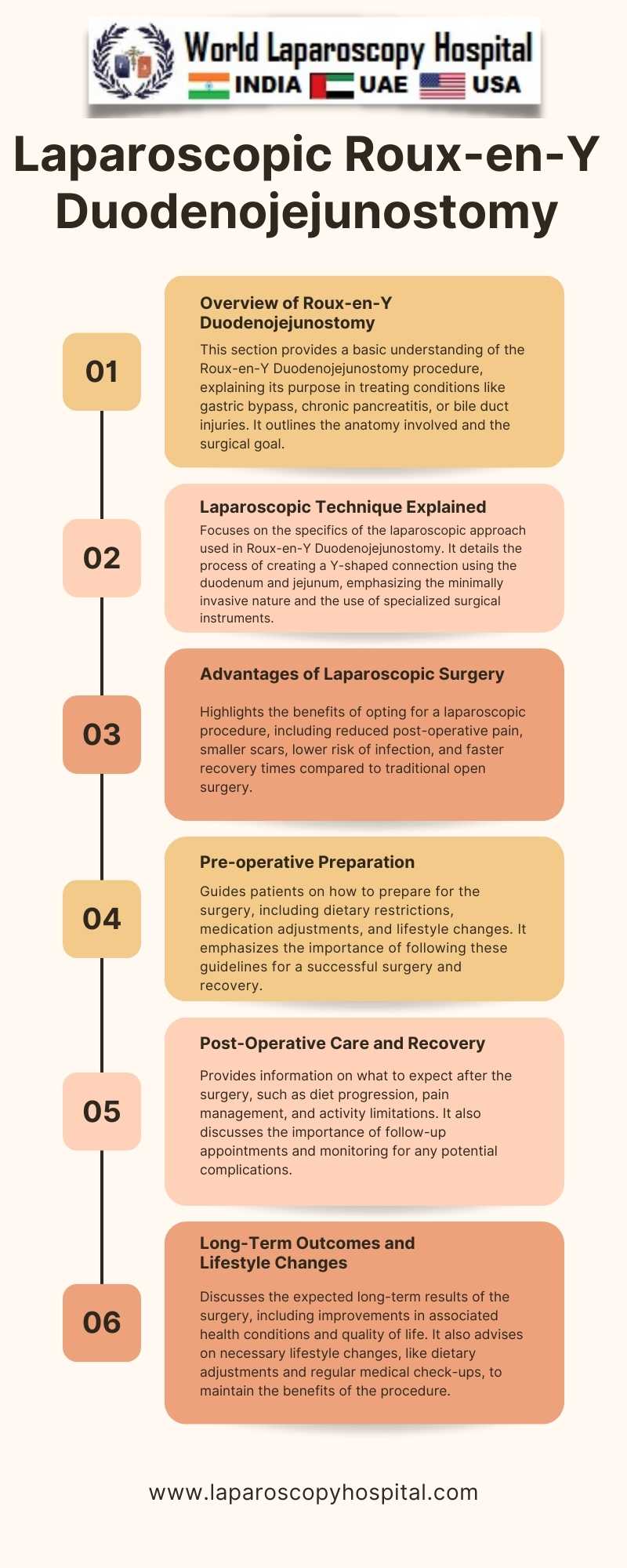Advancements in Laparoscopic Roux-en-Y Duodenojejunostomy: A Modern Surgical Perspective
Advancements in Laparoscopic Roux-en-Y Duodenojejunostomy: A Modern Surgical Perspective
In recent years, the field of surgery has witnessed a significant evolution, particularly in minimally invasive techniques. One such advancement is in the domain of laparoscopic Roux-en-Y Duodenojejunostomy, a surgical procedure primarily used to treat conditions like duodenal obstructions, chronic pancreatitis, or as part of a gastric bypass surgery. This article delves into the modern surgical perspective on this procedure, highlighting its advancements and implications for patient care.

The Evolution of Technique
Traditionally, Roux-en-Y Duodenojejunostomy was performed as an open surgery, involving large incisions and extended recovery times. The advent of laparoscopic techniques revolutionized this approach. Using small incisions, surgeons insert a laparoscope – a thin tube with a camera – and other specialized instruments to perform the surgery. This minimally invasive approach offers several advantages over open surgery, including reduced postoperative pain, shorter hospital stays, lower risk of infections, and quicker return to normal activities.
Technological Integration
Recent years have seen the integration of advanced technologies in laparoscopic surgeries. High-definition cameras and improved surgical instruments offer better visualization and precision. Moreover, the emergence of robotic-assisted laparoscopic surgery further enhances the surgeon's dexterity and control, allowing for more precise suturing and manipulation of tissues. Robotic systems, like the da Vinci Surgical System, provide a three-dimensional view and articulated instruments that mimic the movements of the human hand with greater range and stability.
Enhanced Training and Simulation
With the complexity of laparoscopic Roux-en-Y Duodenojejunostomy, training and skill development are crucial. Modern surgical education increasingly incorporates simulation-based training. Surgeons practice on high-fidelity models or virtual reality simulators, allowing them to hone their skills in a risk-free environment. This training is essential for mastering the intricate maneuvers required in laparoscopic procedures and ensures a higher standard of patient care.
Improved Patient Outcomes
The advancements in laparoscopic Roux-en-Y Duodenojejunostomy have led to improved patient outcomes. Studies indicate lower rates of postoperative complications like wound infections and hernias compared to open surgeries. Additionally, the cosmetic benefits of smaller scars contribute positively to patient satisfaction and psychological well-being.
Future Directions
Looking ahead, the field of laparoscopic surgery is poised for further innovation. Developments in augmented reality (AR) and artificial intelligence (AI) could provide real-time data and imaging enhancements during surgery. Research in tissue engineering and regenerative medicine might also offer new solutions for post-surgical recovery and healing.
Conclusion
The advancements in laparoscopic Roux-en-Y Duodenojejunostomy reflect the broader trends in surgical practice towards minimally invasive techniques. These developments not only enhance surgical precision and safety but also significantly improve the patient experience. As technology continues to evolve, it holds the promise of further elevating the standards of surgical care, making complex procedures like laparoscopic Roux-en-Y Duodenojejunostomy safer, more efficient, and more accessible.
In recent years, the field of surgery has witnessed a significant evolution, particularly in minimally invasive techniques. One such advancement is in the domain of laparoscopic Roux-en-Y Duodenojejunostomy, a surgical procedure primarily used to treat conditions like duodenal obstructions, chronic pancreatitis, or as part of a gastric bypass surgery. This article delves into the modern surgical perspective on this procedure, highlighting its advancements and implications for patient care.

The Evolution of Technique
Traditionally, Roux-en-Y Duodenojejunostomy was performed as an open surgery, involving large incisions and extended recovery times. The advent of laparoscopic techniques revolutionized this approach. Using small incisions, surgeons insert a laparoscope – a thin tube with a camera – and other specialized instruments to perform the surgery. This minimally invasive approach offers several advantages over open surgery, including reduced postoperative pain, shorter hospital stays, lower risk of infections, and quicker return to normal activities.
Technological Integration
Recent years have seen the integration of advanced technologies in laparoscopic surgeries. High-definition cameras and improved surgical instruments offer better visualization and precision. Moreover, the emergence of robotic-assisted laparoscopic surgery further enhances the surgeon's dexterity and control, allowing for more precise suturing and manipulation of tissues. Robotic systems, like the da Vinci Surgical System, provide a three-dimensional view and articulated instruments that mimic the movements of the human hand with greater range and stability.
Enhanced Training and Simulation
With the complexity of laparoscopic Roux-en-Y Duodenojejunostomy, training and skill development are crucial. Modern surgical education increasingly incorporates simulation-based training. Surgeons practice on high-fidelity models or virtual reality simulators, allowing them to hone their skills in a risk-free environment. This training is essential for mastering the intricate maneuvers required in laparoscopic procedures and ensures a higher standard of patient care.
Improved Patient Outcomes
The advancements in laparoscopic Roux-en-Y Duodenojejunostomy have led to improved patient outcomes. Studies indicate lower rates of postoperative complications like wound infections and hernias compared to open surgeries. Additionally, the cosmetic benefits of smaller scars contribute positively to patient satisfaction and psychological well-being.
Future Directions
Looking ahead, the field of laparoscopic surgery is poised for further innovation. Developments in augmented reality (AR) and artificial intelligence (AI) could provide real-time data and imaging enhancements during surgery. Research in tissue engineering and regenerative medicine might also offer new solutions for post-surgical recovery and healing.
Conclusion
The advancements in laparoscopic Roux-en-Y Duodenojejunostomy reflect the broader trends in surgical practice towards minimally invasive techniques. These developments not only enhance surgical precision and safety but also significantly improve the patient experience. As technology continues to evolve, it holds the promise of further elevating the standards of surgical care, making complex procedures like laparoscopic Roux-en-Y Duodenojejunostomy safer, more efficient, and more accessible.
No comments posted...
| Older Post | Home | Newer Post |

